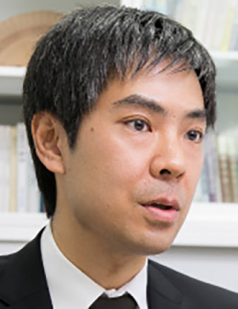

报告题目:Building block approach to artificial photosynthesis
报告时间:2020年10月23日(星期五)上午9:30-11:00
报告地点:腾讯会议
会议ID: 495 095 507
报 告 人:Prof. Kazuhiko Maeda(副教授、东京工业大学)
报告摘要:
Metal oxide nanosheets derived from the layered counterparts have attracted attention in various fields due to their unique structural properties. The anisotropic feature of nanosheets, having a thickness of ~1 nm and lateral dimensions ranging from several hundred nanometers to a few micrometer, is advantageous for heterogeneous photocatalysis, as the diffusion length of photogenerated carriers to the surface is shortened, leading to higher activity.1
It is also known that certain nanoparticulate metals or metal oxides on a semiconductor photocatalyst work as cocatalysts to promote water reduction and/or oxidation.2 In heterogeneous photocatalysis, the effect of cocatalyst size on the water-splitting performance had not been examined at sizes smaller than 1 nm due to the lack of an effective preparation method and a suitable photocatalyst. We have demonstrated that metal nanoclusters (such as Pt) of <1 nm in size could be deposited on the interlayer nanospace of kca2nb3o10 using the electrostatic attraction between a cationic metal complex and a negatively charged ca2nb3o10– sheet, without the aid of any additional reagent.3 the material obtained exhibited 8 times greater photocatalytic activity for overall water splitting under band-gap irradiation than the previously reported analog using a ruo2 promoter. this study highlighted the superior functionality of <1 nm pt nanoclusters for photocatalytic overall water splitting.
With further modification by a ruthenium(II) photosensitizer, this material also worked as a H2 evolution photocatalyst in visible-light-driven Z-scheme water splitting, in combination with a WO3-based O2 evolution photocatalyst and a triiodide/iodide redox couple.4 Pt-intercalated HCa2Nb3O10 nanosheets further modified with amorphous AlOx clusters demonstrated a remarkable photocatalytic activity with a dye-based turnover number and frequency for H2 evolution of 4580 and 1960 h–1, respectively, which were by far the highest among dye-sensitized nonsacrificial photocatalytic systems ever reported.
1) K. Maeda and T. E. Mallouk, Bull. Chem. Soc. Jpn. 2019, 92, 38.
2) K. Maeda and K. Domen, Bull. Chem. Soc. Jpn. 2016, 89, 627.
3) T. Oshima, D. Lu, O. Ishitani and K. Maeda, Angew. Chem. Int. Ed. 2015, 54, 2698.
4) T. Oshima, S. Nishioka, Y. Kikuchi, S. Hirai, K.-i. Yanagisawa, M. Eguchi, Y. Miseki, T. Yokoi, T. Yui, K. Kimoto, K. Sayama, O. Ishitani, T. E. Mallouk, K. Maeda. J. Am. Chem. Soc. 2020, 142, 8412.

报告人简介:
Kazuhiko Maeda, 2007年博士毕业于东京大学,师从Kazunari Domen教授。2008-2009年在美国宾夕法尼亚州立大学从事博士后研究(合作导师:Thomas E. Mallouk教授),2009年加入东京大学任助理教授,2012年加入东京工业大学任副教授。2010-2014年期间任命为PRESTO/JST研究员,主要的研究兴趣是光能到化学能转化的多相光催化研究,特别是光解水和二氧化碳固定。